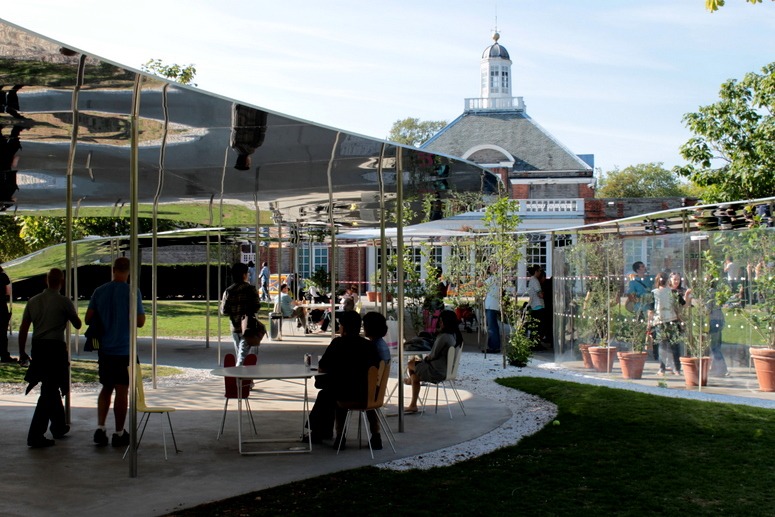The Saana Pavilion is the most beautiful, so far, in the Serpentine Galleries series of Summer Pavilions, but it is a disappointment for no fault of the architects. Obviously, it should have been integrated with an equally brilliant garden design.
The Online Etymology Dictionary has this for Pavilion: 1297, “large, stately tent,” from O.Fr. paveillun (12c.), from L. papilionem (nom. papilio) “tent,” lit. “butterfly,” on resemblance of wings. Of unknown origin. Meaning “open building in a park, etc., used for shelter or entertainment” is attested from 1687. Saana have done the butterfly idea to perfection and it integrates with the plane trees better than any of its predecessors. But it could have been so much beautiful if integrated with, for example, water and bamboos. I hear the pavilion has been sold, so perhaps I will visit a garden some day and find this has been done. I hope so.
My suggestion to the Director and Trustees of the Serpentine Gallery is that they move heaven and earth, in their customary style, to raise additional funding for a combined pavillion+garden and then invite entries from integrated professional teams. This would:
- easily outdoo the best designs at the Chelsea Flower Show, which are often architecturally disappointing (see design reviews of Chelsea Flower Shows and Haruko Seki’s 2008 Silver Moonlight Garden)
- attract many extra visitors and far more media coverage, because gardens get far more media attention than buildings
- match the etymology of ‘pavilion’ as a building integrated with its setting
- achieve the wondrous goal of encouraging indoor and outdoor designers to work together on every possible occasion
- in all probability, make a series of contributions to the cause of sustainable green design
The Serpentine Gallery has a better opportunity to promote garden and landscape design than any other gallery in London: the Serpentine itself was once a leading-edge design. I think it is one of those occasions when an opportunity becomes a duty.


Fantastic idea! I hope the Director and Trustees of the Serpentine Gallery are equally as enthusiastic….
The Barcelona Pavilion by Mies Van der Rohe must be the most successful and influential pavilion design I know. It still inspires and takes your breath away….[ http://www.channel4.com/4homes/architecture/our-favourite-buildings/george-clarke-s-five-favourite-buildings-08-10-22_p_3.html ]
The key words are simplicity and beauty. The simplicity and beauty provide a marriage between the architecture and the formal landscape setting. It is designed in such an astounding way that the design is invisible!
Mies according to Therese O’Malley and Marc Treib in ‘Regional garden design in the United States’ was responsible for a new conception in interior and exterior spatial relationships(p24);
“Emphasising the plane rather than the mass, and reducing the number of firm corners, the architect had effectively effaced the distinction between interior room and exterior courtyard.”
I 200% agree about the Mies van der Rohe pavilion, both regarding its beauty and its influence – and that neither would have been so great if it were not a fabulous combination of indoor and outdoor design http://www.gardenvisit.com/garden/mies_van_der_rohe_pavilion . The world would have better cities if this example had attracted more followers. I don’t know what went wrong. Was it the baleful influence of concrete, Walter Gropius, wartime economy or highway engineers?
Pingback: Jean Nouvel Serpentine Pavilion and Garden 2010 | Garden Design And Landscape Architecture Blog – Gardenvisit.com